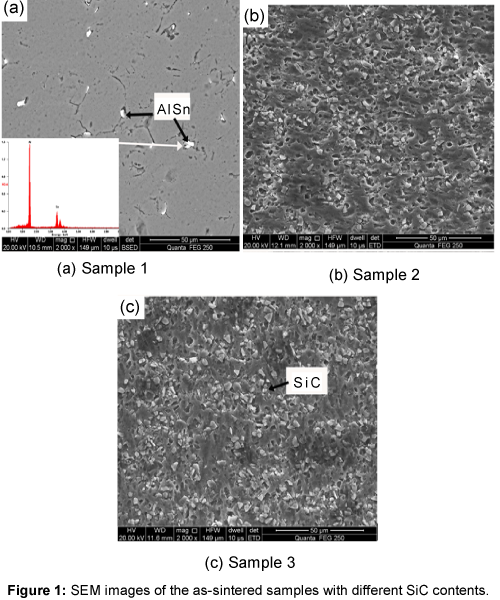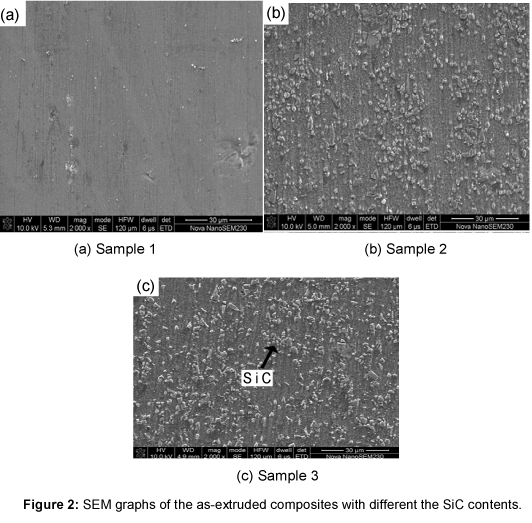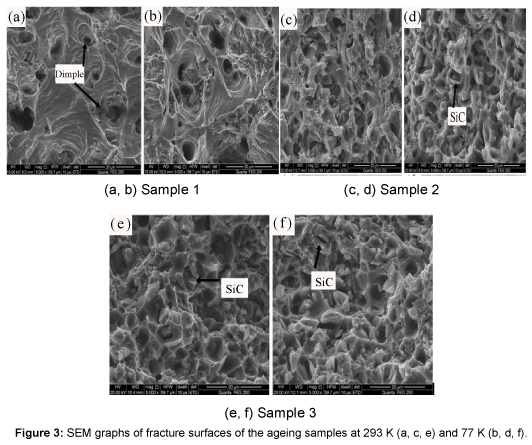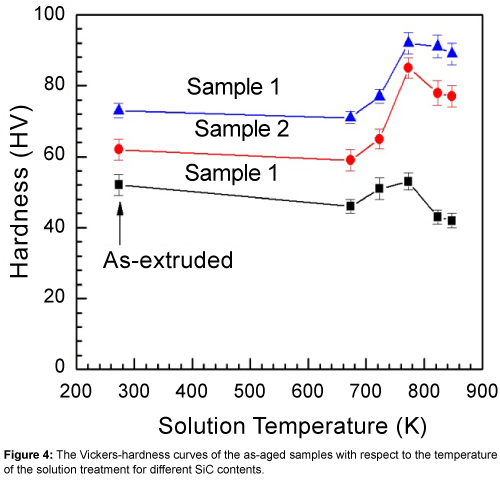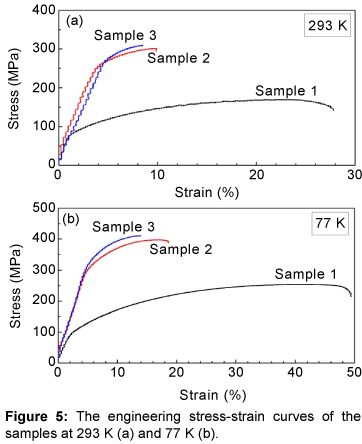Research Article Open Access
Microstructure, Mechanical Properties and Corrosion Behavior of As-Extruded PM Sicp/Al-Mg-Cu-Sn Composites
Shen RJ1,2, Xiao DH1*, Zhou PF1 and Song M1,21State Key Laboratory of Powder Metallurgy, Central South University, Changsha, China
2Shenzhen Research Institute, Central South University, Shenzhen, China
- Corresponding Author:
- Xiao DH
State Key Laboratory of Powder Metallurgy
Central South University, Changsha, China
Tel: +86-731-88877880
Fax: +86-731-88710855
E-mail: daihongx@csu.edu.cn
Received date: March 20, 2016; Accepted date: May 30, 2016; Published date: June 06, 2016
Citation: Shen RJ, Xiao DH, Zhou PF, Song M (2016) Microstructure, Mechanical Properties and Corrosion Behavior of As-Extruded PM Sicp/Al-Mg-Cu-Sn Composites. J Powder Metall Min 5:141. doi:10.4172/2168-9806.1000141
Copyright: © 2016 Shen RJ, et al. This is an open-access article distributed under the terms of the Creative Commons Attribution License, which permits unrestricted use, distribution, and reproduction in any medium, provided the original author and source are credited.
Visit for more related articles at Journal of Powder Metallurgy & Mining
Abstract
SiC particle reinforced powder metallurgy (PM) Al-Mg-Cu-Sn matrix composites were fabricated by hot-press sintering and hot extrusion. The effects of solution treatment temperature and SiC particle content on the microstructure, mechanical properties and corrosion behavior of the composites were studied using scanning electron microscopy, Vickers hardness testing, tensile testing and electrochemical experiments. The results show that increasing SiC particle content improves the tensile strength of the Al-Mg-Cu-Sn matrix composites between room temperature and cryogenic temperature. The yield strength of Al-Mg-Cu-Sn composite with 10 vol.% SiC particle content between at 293 K and 77 K increases from 63 MPa to 276 MPa and 106 MPa to 327 MPa, respectively. The solution treatment temperature distinctly affects the Vickers hardness of the SiCp/Al-Mg-Cu-Sn composites. The maximum Vickers hardness of the 10 vol.% SiCp/Al-Mg-Cu-Sn composite is 92 HV after solution treatment at 773 K followed by ageing. The corrosion behavior of Al-Mg-Cu-Sn matrix composites is affected by both the SiC particle content and solution treatment temperature
Keywords
Metal matrix composites; Solution treatment; SiC particle; Microstructure; Properties
Introduction
Aluminum matrix composites reinforced by SiC particles are widely used in aviation, aerospace, automotive, electronics, and other fields due to their high specific strength and specific stiffness, excellent wear resistance, and low density. Research efforts regarding such composites have been primarily focused on the characteristics of SiC particles, aluminum matrix selection, and the effect of the preparation process on the structure and performance of the composites [1-7].
Al-Mg alloys are one type of the aluminum alloys that can be heat strengthened, and are widely used as automotive body panel material. The microstructure and properties of the alloys can be further controlled by micro-alloying with Si and Cu elements. In general, SiC particle reinforced Al-Mg-based composites are prepared by casting methods, including infiltration casting, transfer molding and gravity casting method, etc. In this method, the matrix alloy is first melted, and the SiC particles are subsequently added to the melt, or the melt is added to a previously prepared SiC body. One disadvantage of this method is the heterogeneous distribution of the SiC particles in the matrix [5-12]. The powder metallurgy (PM) method, as one of the advanced preparation methods, is also commonly used to prepare SiC particle reinforced Al- Mg-based composite materials [13-17]. Asgharzadeh studied the effect of the SiC content on the SiC distribution and microstructure during the sintering process of a SiC/Al-1.0Mg-0.6Si-0.2Cu-0.1Fe (mass%) composite [15]. Their results indicated that SiC particles reduced the sintering density of the composite. Yan et al. [16] studied the influence of SiC particle contents (25~35 vol.%) on a SiC/Al-1.0Mg-0.6Si- 0.2Cu (mass%) composite. It showed that the densification, thermal expansion coefficient of the composite and the tensile strength of the composite decreased with the increasing SiC particle content.
The microstructure and properties of SiC particle reinforced PM Al-Mg-based composites are affected by the particle size and volume fraction of the SiC particles, the matrix alloy composition and the sintering process employed [7,9,10,12,15]. Subsequent thermomechanical treatment processes also have an effect on the mechanical properties of composite material, such as the solution treatment process [11]. However, the effects of solution treatment temperature and SiC particle on SiC/Al-Mg-Cu-Sn composites are not reported in the literature. This work is purposed to study the effects of solution treatment temperature and SiC particle contents on the microstructure, mechanical properties and corrosion behavior of PM SiC/Al-Mg-Cu- Sn composites.
Experimental Methods
Spherical Al-0.64 Mg-0.60 Cu-0.36 Sn-0.22 Fe-0.18 Zn-0.04 Si (mass%) powder (Taigang Group Aluminium Powder Co., China) and SiC particles (99.6%) (Xuzhou Jiechuang New Material Technology Co., China) were used as the raw materials. The average diameters of the matrix alloy powders and SiC particles are 20 μm and 10 μm, respectively, with the SiC contents being 0 vol.% (Sample 1), 5 vol.% (Sample 2), and 10 vol.% (Sample 3). The three mixed powders were mechanically milled for 24 hours in a planetary ball milling system in absolute ethyl alcohol (Changsha Chemistry Co. China) under the Ar atmosphere using 10 mm diameter WC-5Co balls (Zhuzhou Cemented carbide Co. Chin) as the milling bodies. The ball-to-powder weight ratio was 3:1 and the milling speed was 300 rpm. The milled powder was first dried in a vacuum oven, and then pressed into a cylindrical compact under a pressure of 350 MPa. The compacts were then hotpress sintered at 873 K for 2 h under vacuum condition. The sintered samples were hot extruded into bar samples at 703 K with an extrusion ratio of 10:1. The bar samples were solution treated at 673 K, 723 K, 773 K, 823 K, and 848 K for 5 h, respectively, and then water quenched followed by aging for 7.5 h at 423 K.
The density of the sintered composites was measured by Archimedes method. The hardness was tested using a Micromets 5104 Vickers hardness tester, and the reported result for each sample represents the average of 5 testing points. The as-aged samples subjected to solution treatment at 773 K were sectioned into samples with dimensions 15 mm × 3.5 mm × 2 mm. The tensile properties were tested on an Instron 3369 mechanical testing machine at a rate of 1 mm/min at both 293 K and 77 K. The sintered samples, the extruded samples and the tensile fracture morphology were observed by scanning electron microscopy (SEM) using an FEI Nova NanoSEM 230 high-resolution field emission microscope. The corrosion behaviors of the materials are determined by the Tafel curves of the as-aged samples in 3.5% NaCl solution by a CHI660E electrochemical workstation (CH Instruments, Inc., USA).
Results and Discussion
Microstructure of the samples
Figure 1 shows the microstructures of the as-sintered base alloy and SiCp/Al-Mg-Cu-Sn composites. No obvious pores and other defects were observed in the three samples. Archimedes tests showed that the densities of all the three samples were greater than 95%, indicating that material densification was relatively high after sintering. A number of very small pores can be observed on the surface of Sample 1 (Figure 1a), which formed due to the escape of gas trapped in the powder that had not been completely eliminated during the vacuum hot pressing sintering process. Some white AlSn phases are homogeneously distributed along the grain boundaries (Figure 1a). As shown in Figure 1b and 1c, the SiC particles of Samples 2 and 3 distributed relatively uniformly and no obvious agglomeration can be observed. The number of the small pores reduced significantly compared to those observed in Sample 1, indicating that the addition of SiC particles contribute to the densification of the sintered alloy. High magnification examination (not shown) indicated that SiC particles underwent no obvious interfacial reaction with the Al matrix.
The microstructures of the hot-extruded samples are shown in Figure 2. The matrix grains of the sample 1 were fine and the microstructure was fibrous after hot extrusion. For Sample 2 with 5 vol.% SiC particles, the SiC particles redistributed with some broken particles. This is because the SiC particles are the hard, brittle ceramic particles that tend to fracture during the extrusion process (Figure 2b). When the SiC particle content was further increased to 10 vol.%, the SiC particles in Sample 3 redistributed more fibrously and some agglomeration occurred (Figure 2c).
Figure 3 shows the SEM graphs of the fracture surfaces of the samples after tensile testing at 293 K and 77 K. Sample 1 was a typical ductile fracture (Figure 3a and 3b) with obviously large-sized dimples, indicating its good plastic deformation ability. With 5 vol.% SiC particles, the fracture of Sample 2 was mainly due to matrix ductile rupture, and the second crack occurred simultaneously (Figure 3c and 3d). Compared to the Sample 1, the dimple size of Sample 2 reduced significantly and the broken SiC particles can be found in the dimples. This indicates the decrease of the elongation for the composites. The further analysis shows there are no obviously interfacial reactions traces at the interface between SiC particles and the matrix. Figure 3e and 3f show that Sample 3 has different sizes and depths of the dimples. The large-sized dimples were caused by the interfacial disengagement between SiC particles and the matrix.
Mechanical properties of the samples
Figure 4 shows the Vickers hardness curves of the as-aged samples after solution treatment at different temperatures. With the volume fraction of the SiC particles increasing, the hardness of the as-extruded composites (Figure 4) increased significantly. The Vickers hardness values of the as-extruded Samples 2 and 3 were 62 HV and 73 HV, respectively, which increased by 19% and 21%, respectively, compared to that of Sample 1. The increased hardness is due to the dispersion strengthening of the added SiC particles, as was reported in the previous literature [18].
The solution treatment temperature also has a significant effect on the hardness of the material. After solution treatment at 673 K, the Vickers hardness values of the three as-aged samples decreased compared to those of the as-extruded samples. Similar phenomena have been reported in literature [19]. With increasing solution treatment temperature, the hardness of the as-aged materials increased, with the maximum value obtained at 773 K. The hardness of Samples 2 and 3 increased compared with that of Sample 1. The hardness of Samples 2 and 3 increased by more than 20% compared to the as-extruded materials, while the hardness of Sample 1 was essentially unchanged relative to its as-extruded hardness after solution treatment at 773 K. This demonstrates that solution treatment has an obvious effect on the composites reinforced by SiC particles. For the solution treatment temperature of 823 K, the hardness of Samples 1 and 2 decreased significantly, while that of Sample 3 did not show the obvious change. When the solution treatment temperature increased further to 848 K, the hardness values of the as-aged samples were further reduced. The burning phenomenon was also observed in the three materials, and result in the decrease of the hardness of the samples. The above results demonstrate that increasing the volume fraction of the SiC particles enhances the effects of solution treatment on SiC/Al-Mg-Cu- Sn composites.
Table 1 shows the mechanical properties of the composites after tensile testing at the room temperature (Table 1). After adding 5 vol.% SiC, the ultimate tensile strength (σb) of Sample 2 was found to increase by 78.5% from 168 MP to 300 MPa, with that of Sample 3 improved by 84.5%. The yield strength (σ0.2) of Samples 2 and 3 at the room temperature increased by 285% and 332%, respectively, compared to that of Sample 1. These results demonstrate that the addition of SiC particles can improve the strength of Al-Mg-Cu-Sn alloys. The fracture elongation (δ) results at 293 K show that the elongation of the composites decreased from 23.5% to 8.1%. All of the three materials exhibit hardening, yield and plastic deformation (Figure 5).
| Sample | Testing temperature | σb (MPa) | σ0.2 (MPa) | δ (%) |
|---|---|---|---|---|
| Sample 1 | 293 K | 168 | 63 | 23.5 |
| 77 K | 251 | 106 | 48.5 | |
| Sample 2 | 293 K | 300 | 263 | 9.8 |
| 77 K | 397 | 305 | 16.8 | |
| Sample 3 | 293 K | 310 | 276 | 8.1 |
| 77 K | 411 | 327 | 13.5 |
Table 1: Tensile properties of the samples at 293K and 77 K.
After tensile testing at 77 K, the σb and δ of Sample 2 increase from 300 MPa to 397 MPa, 9.8% to 16.8%, respectively, compared to that of Sample 1 (Table 1). It means that the SiCp/Al-Mg-Cu-Sn composites exhibit a strong temperature dependence of the tensile strength between 293 K and 77 K. This is different compared with other fields of materials, where an inverse dependence of ductility and strength is invariably seen [20].
Corrosion behavior of the samples
To determine the influence of the SiC particle content and solution treatment temperature on the corrosion behavior of the matrix material, the Tafel curves in a 3.5% NaCl solution at room temperature were obtained for the as-aged samples subjected to solution treatment at different temperatures, as shown in Figure 6. The electrochemical corrosion parameters obtained from the Tafel curves are shown in Table 2. The solution treatment temperature obviously affects the corrosion resistance of the as-aged samples with different SiC contents. For Sample 1, the corrosion potential gradually decreases by increasing the solution treatment temperature from 673 K to 823 K (Figure 6a). The as-aged specimen shows the worst corrosion resistance at this solution temperature with 823 K. Table 2 shows that the corrosion current (Icorr) of Sample 1 exhibits little change with respect to the solution treatment temperature, indicating that the solution treatment temperature has no obvious influence on the corrosion rate of Sample 1. For Sample 2 and Sample 3, the corrosion potential (Ecorr) decreases to a minimum with increasing solution treatment temperature to 773 K, and then increases with further increasing solution treatment temperature (Figure 6b and 6c). This indicates that the composite corrosion resistance firstly decreases and then increases with the increasing solution treatment temperature. Samples 2 and 3 exhibit a maximum value of Icorr at 773 K, indicating that the material has a maximum corrosion rate at this solution temperature. Table 2 also demonstrates that the corrosion behaviors of the materials vary with respect to the SiC particle content when they were subjected to solution treatment at the same temperature. After solution treatment at 773 K, the value of Ecorr decreases with the increasing SiC particle content, indicating that the corrosion resistance trends of the samples diminished. The solution treatment temperature of 823 K indicates a better corrosion resistance of composites containing SiC particles because of the higher corrosion potentials compared with that of Sample 1.
| Sample | Solution Temperature(K) | ECORR(V) | ICORR (μA/cm2) |
|---|---|---|---|
| Sample 1(0 vol. %SiC) | 673 | -0.8594 | 59.38 |
| 723 | -0.9468 | 39.05 | |
| 773 | -1.0006 | 44.23 | |
| 823 | -1.1618 | 73.99 | |
| 848 | -1.1229 | 76.87 | |
| Sample 2(5 vol. %SiC) | 673 | -0.7618 | 42.81 |
| 723 | -0.9946 | 27.2 | |
| 773 | -1.0872 | 160.57 | |
| 823 | -1.0363 | 126.51 | |
| 848 | -1.1697 | 72.66 | |
| Sample 3(10 vol. %SiC) | 673 | -0.7727 | 21.59 |
| 723 | -0.8604 | 42.24 | |
| 773 | -1.105 | 341.39 | |
| 823 | -1.0246 | 137.25 | |
| 848 | -0.8511 | 58.81 |
Table 2: Electrochemical data of the samples after different solution treatment.
The corrosion resistance of SiCp/Al-Mg composites depends on many factors, such as the SiC contents and size, Al-Mg alloy composition, Si/Mg molar ratios, heat treatment, microstructure, environment, and properties of the Al2O3 film covering the alloy matrix surface in the aggressive solution [21-25]. The silicon carbide particles are conductive and act as local cathodes for the reduction of oxygen in the composites [21,22]. The study by Zakaria showed that reducing the SiC particles size and/or increasing the volume fraction of the SiC particulates reduces the corrosion rate of the Al/SiC composites [21]. However, the mechanism of the solution treatment temperature on the corrosion behavior of SiCp/Al-Mg-Cu-Sn composites requires further studies.
Conclusions
1. The solution treatment temperature has a minor effect on the hardness of the as-extruded PM Al-Mg-Cu-Sn alloy, but a greater effect on SiCp/Al-Mg-Cu-Sn composites. The maximum hardness of composites was obtained after solution treatment at 773 K.
2. The tensile properties of SiCp/Al-Mg-Cu-Sn composites increase significantly relative to those of the base alloy. After solution treatment at 773 K, the yield strength of the as-aged Al-Mg-Cu-Sn alloy containing 10 vol% SiC particles increases from 106 MPa to 327 Mpa. The tensile strength of the SiCp/Al-Mg-Cu-Sn composites exhibits a strong dependence of the temperature between at 293 K and 77 K.
3. The corrosion behavior of the matrix alloy is affected by the added SiC particles as well as the solution temperature.
Acknowledgments
This work is supported by National Natural Science Foundation of China (No. 51301206 and 51271152) and Shenzhen Planned Science and Technology program (No. JCYJ20140509142357196).
References
- Dsa DK, Mishra PC, Singh S (2014) Properties of ceramic-reinforced aluminium matrix composites-a review. Inter. J Mech Mater Eng 9: 12-18.
- MazaheryMO,Shabani (2013) Application of the Extrusion to Increase the Binding between the Ceramic Particles and the Metal Matrix: Enhancement of Mechanical and Tribological Properties. J Mater SciTechn 29: 423-428.
- Shen RJ, Sun C, Song M, Du Y (2012) Effect of stirring time and extrusion on microstructure and mechanical properties of SiC reinforced pure Al matrix composites. Mater SciEng Powder Metall 17: 604-610.
- Jin P, Liu Y, Li X, Xiao BL (2009) Application of particle reinforced aluminumcomposite materials inthe aerospace field Mater Rev 11: 1-10.
- Parka BG, Crosky AG, Hellier AK (2008) Fracture toughness of microsphere Al2O3-Al particulate metal matrix composites. Composites: Part B 39: 1270-1275.
- Casati R, Vedani M (2014) Metal matrix composites reinforced by nano-particles: A Review. Metal 4: 65-83.
- Salvo L, Lesperance G, Suery M, Legoux JG (1994) Interfacial reactions and age-hardening in Al-Mg-Si metal-matrix composites reinforced with SiC particles. Mater SciEngA177: 173-183.
- Valdez S, Ascencio J, Casolco SR, Pech-canul MI (2014) The Oxidation of matrix composite AlMg reinforcement with SiC. Inter. J ElectrochSci9: 6225-6234.
- Alaneme KK, Adewale TM, Olubambi PA (2008) Corrosion and wear behaviour of Al-Mg-Si alloy matrix hybrid composites reinforced with rice husk ash and silicon carbide. J Mater Research Techn 3: 9-16.
- Valdez S, Campill B, Perez R, Martine L, Garcia A (2008)Synthesis and microstructural characterization of Al-Mg alloy-SiC particle composite. Mater Letters 62: 2623-2625
- Xiao DH, Chen KH, Huang BY (2007) Microstructure and mechanical properties of high volume fraction SiCp reinforced heat resistant aluminium matrix composites. Spec Cast Nonferrous Alloys 27: 7-10.
- Mitra R, Raov SC, Maii R (2004)Stability and response to rolling of the interfaces in cast Al-SiCp and Al-Mg alloy-SiCp composites. Mater SciEngA379: 391-400.
- Chawla N, Willams JJ (2002) Mechanical behavior and microstructure characterization of sinter-forged SiC particle reinforced aluminum matrix composites. J Light Metals 2: 215-227
- Xiong BW, Xu ZF, Yan QS (2011) Effects of SiC volume fraction and aluminum particulate size on interfacial reactions in SiCnanoparticulate reinforced aluminum matrix composites. J Alloys Compd509: 1187-1191
- Asgharzadeh H, Simchi A (2009)Supersolidus liquid phase sintering of Al6061/SiC metal matrix composites. Powder Metall 52: 28-35.
- Gun LP, Wang AQ, Xie JP (2013) Effect of SiC contents on mechanical properties of SiC/6061Al composites. Powder Metall. Industry 23: 30-34.
- Ahn HK, Yu CH (2001) Effect of SiC volume fraction on the age-hardening behavior in SiC particulate-reinforced 6061 aluminum alloy composites. Metals andMater Inter 7: 1-7.
- Ozben T, Kilichap E (2008) Investigation of mechanical and machinability properties of SiC particle reinforced Al-MMC. J Mater EngPerform198: 220-225.
- Liu P, Ai AQ, XieJPc(2015) Effect of heat treatment on microstructure and mechanical properties of SiCp/2024 aluminum matrix composite. J Wuhan UniversTechnol -MaterisSci 30: 1229-1233.
- Ritchie RO (2011)The conflicts between strength and toughness. Nat Mater10: 817-822.
- Zakaria HM (2014)Microstructural and corrosion behavior of Al/SiC metal matrix composites. Ain Shams Eng J 5: 831-838
- Bhat MSN, Surappa MK, SudhakerNayakHV (1991) Corrosion behaviour of silicon carbide particle reinforced 6061/Al alloy composites. J MaterSci 26: 4991-4996.
- Pardo MC, Merino S, Viejo F (2005) Influence of reinforcement proportion and matrix composition on pitting corrosion behavior of cast aluminum matrix composites. CorrosSci 47: 1750-1764.
- Escalera L, Pech-Canul MA, Pech-Canul MI, Quintana P (2009)Corrosion characteristics of Al-Si-Mg/SiCp composites with varying Si/Mg molar ratio in neutral chloride solutions. MaterCorros60: 683-689.
- Naya J, Hebbar KR (2008) Corrosion inhibition of T6 treated 6061 Al-SiC(p) composite In Hydrochloric acid. Trans Indian Inst Met61: 221-224.
Relevant Topics
- Additive Manufacturing
- Coal Mining
- Colloid Chemistry
- Composite Materials Fabrication
- Compressive Strength
- Extractive Metallurgy
- Fracture Toughness
- Geological Materials
- Hydrometallurgy
- Industrial Engineering
- Materials Chemistry
- Materials Processing and Manufacturing
- Metal Casting Technology
- Metallic Materials
- Metallurgical Engineering
- Metallurgy
- Mineral Processing
- Nanomaterial
- Resource Extraction
- Rock Mechanics
- Surface Mining
Recommended Journals
Article Tools
Article Usage
- Total views: 12151
- [From(publication date):
December-2016 - Apr 07, 2025] - Breakdown by view type
- HTML page views : 11166
- PDF downloads : 985

